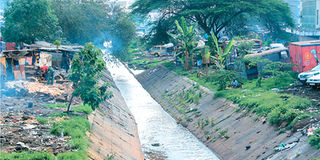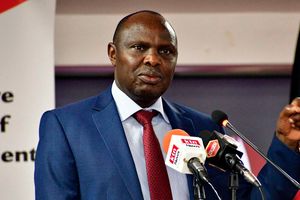Cleaning up Nairobi River will take time, money and miracle

A section of the Nairobi River near the Globe Cinema roundabout. About 125,000 people will be moved away from the river banks as part of a campaign to clean it up and turn it into a picnic and fishing site. Photos/ MICHAEL MUTE
What you need to know:
- The key challenges are huge shortfall in the Budget and biting recession in Europe
It will take a long time before city residents go fishing or swimming in Nairobi River despite a proposed Sh12 billion clean-up programme that started nine years ago.
Once completed, the programme lead to the overhaul of the city’s sewerage system and see over 125,000 slum dwellers moved from sites near the river.
Despite the multi-billion shilling clean-up drive, now in its final year, the Nairobi River continue to choke with garbage, industrial waste, agro and petro-chemicals and heavy metals among other pollutants which have led to the extinction of aquatic life in the river and made it into an eyesore.
The pollution has led to water-borne diseases and scarcity of safe water for city residents who are also exposed to toxic substances and heavy metal poisoning.
For the clean-up drive to be successful, the Government is expected to contribute about Sh4 billion to the project. Another Sh5 billion will be from the African Development Bank and Sh3 billion from donors.
However, the Government is experiencing a Sh127 billion Budget deficit this financial year while many donor countries are in recession due to the global financial crisis. This could jeopardise the chances of success for the programme.
The plan could further be scuttled by a population explosion expected to reach its peak in the next ten years, once as half of the population, now in their teens, enter the reproductive age.
According to the State of Kenya Population 2008 report released last month, the number of people in Kenya will almost have doubled to about 65 million in 20 years.
The plan to move 125,000 from dwellings built on river banks could also spark opposition, as has happened with the Kibera slum upgrading project, which was greeted with resistance.
According to Eng Anthony Kimani, the acting director of compliance at the National Environmental Management Agency (Nema), the biggest polluter of the rivers in Nairobi is the City Council and water companies.
“In many places the sewers are either broken or in some estates they don’t exist at all. Consequently residents discharge their waste into the nearest water bodies,” he told the Nation in an interview last week.
However, the Nairobi Water Company says it has embarked on a Sh8 billion Word Bank funded plan to replace the old and decaying water and sewerage lines.
According to the company’s acting managing director, Sellestine Kiuluku, the replacement programme will take three years.
The sewerage system in Nairobi was built based on 1920s population projections. At the time, the population was less than half a million. Now it has hit the 3 million mark.
According to statistics, over 40 per cent of the households in Nairobi lack access to sanitation. Some estates like Zimmerman do not have a sewerage system and its waste water ends up in Kamiti River which pours its water into the Nairobi River.
The programme will also have to contend with a large number of corporate polluters.
To deal with them, Eng Kimani has proposed a shock and awe strategy like that used against slaughter houses in Dagoretti, which forced them to clean up and find more hygienic waste disposal systems.
“We are soon going to put some people in jail to underline out determination in stopping industries from polluting the rivers,” said Mr Kimani.
However, a manager with one company at the Export Processing Zone blames corruption in the regulatory authorities for failure to prosecute offenders.
Although Nema has for example compiled reports on defaulters, it is yet to take them to court preferring to dialogue with them instead.
While Eng Kimani is optimistic that financial, structural and compliance challenges will be overcome, and that the city will have a clean river in a decade, the biggest challenge is to change Kenyans’ attitude towards waste disposal.
“It is appalling how casual we are in waste disposal,” he said.
Nema is educating wananchi who live and work near rivers on the benefits of keeping the water clean and how to collect and dispose garbage. However, not all are convinced that a change they can see is on the way.
“We have heard all that before,” said Mr Reuben Muasya, who has been repairing vehicles behind Kirinyaga Road for almost 25 years.
According to him, even the rich sometimes volunteer to clean up the river but they are “always in a hurry to get back into their big cars as soon as media cameras are turned away”.
He says he has seen this trend for so many years that he no longer gives it a thought any more.
The Nairobi River Basin Programme was initiated in 1999 and expected to end this year.
Led by UNEP, the programme has amassed a wealth of information on the river that can be useful in moving the project to the next phase.
Clean a few sections
It has also managed to clean a few sections of the river, including that section between the National Museums of Kenya and the Globe Cinema.
Also evident are several public toilets and waste disposal centres along the river but these pale into insignificance when compared to the task ahead.
In July, Mr Achim Steiner, the executive director of UNEP, several Cabinet ministers including the Prime Minister Raila Odinga, held talks on what to do with Nairobi River and other environmental issues affecting the City.
The Ministry of Environment presented a 10-point action plan which proposes to see the rivers cleaned within three years.
The Ministry also proposed to engage the National Youth Service as well as the military in the work.
According to the environment and acting Finance minister John Michuki, the three-year project will require $246 million with the Government contributing 30 per cent of the funds and the rest coming from donors and private companies.
Realising how much the river and its neighbouring communities have been used to attract publicity Mr Muchuki says: “I do not want people who come for cameras.
The time for cameras and television is over. Its time for action.”




